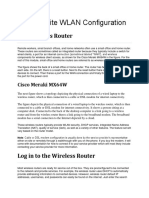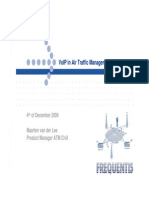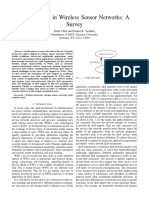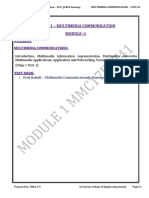Functions of ARP
Functions of ARP
Uploaded by
Cherry Mae Dela RosaCopyright:
Available Formats
Functions of ARP
Functions of ARP
Uploaded by
Cherry Mae Dela RosaCopyright
Available Formats
Share this document
Did you find this document useful?
Is this content inappropriate?
Copyright:
Available Formats
Functions of ARP
Functions of ARP
Uploaded by
Cherry Mae Dela RosaCopyright:
Available Formats
Functions of ARP, IP, ICMP, IPv6 Communications protocol
A communications protocol is a system of digital message formats and rules for exchanging those messages in or between computing systems and in telecommunications. A protocol may have a formal description. From the book (Data Communications and networking 3eForouzan) Internet Protocol address (IP address) is a numerical label assigned to each device participating in a computer network that uses the Internet Protocol for communication. IP needs a protocol called ARP to find the MAC (physical) address of the next hop. This address must be passed to the data link layer, with the IP diagram, to be inserted into encapsulating frame. During datagram deliver, IP needs the services of ICMP to handle unusual situations suck as the occurrence of an error. IP is designed for unicast delivery, one source to one destination. Multimedia and other new applications in the Internet need multicasting delivery, one source to many destinations. For multicasting, IP uses the services of another protocol called IGMP.
IP Internet Protocol ARP Address Resolution Protocol RARP Reverse Address Resolution Protocol ICMP Internet Control Message Protocol IGMP Internet Group Management Protocol
1. Internet Protocol (IP)
An Internet Protocol (IP) address is a numerical identification (logical address) that is assigned to devices participating in a computer network utilizing the Internet Protocol for communication between its nodes (Devices). Their are of version of IP IPv4 : 192.168.100.1 IPv6: 2001:db8:0:1234:0:567:1:1 IP importance
It's importance is IP address is used to identify a device in a network like home address Every time a device need to communicate with some other device IP is used line sending a mail, surfing web. 2. IPV6
Internet Protocol version 6 (IPv6) is a version of the Internet Protocol (IP) intended to succeed Internet protocol Version (IPv4), which currently directs almost all Internet traffic, but is running out of addresses. IPv6 allows up to 2128 addresses, a massive increase from the 232 (about 4.3 billion) addresses possible with IPv4, and includes several other improvements. To gain the full benefits of IPv6, most hosts on the Internet will have to deploy this protocol, as well as the networks connecting them, a difficult translation.
3. ARP / RARP (Address Resolution Protocol)
ARP stands for Address Resolution Protocol. It is used to inform other computers on the network of the computers IP to MAC address translation. That transaction is called an ARP request. ARP is one of the core protocol's used in TCP/IP. There is also Reverse ARP (RARP) which can be used by a host to discover its IP address. In this case, the host broadcasts its physical address and a RARP server replies with the host's IP address.
ARP / RARP (2)
Due to the overwhelming prevalence of IPv4 and Ethernet in general networking, ARP is most frequently used to translate IPv4 addresses (OSI Layer 3) into Ethernet MAC addresses (OSI Layer 2). ARP / RARP (3)
This protocol is used to translate physical addresses to internet protocol (IP) addresses. The Address Resolution Protocol (ARP) is a computer networking protocol for determining a network host's link layer or hardware address when only its Internet Layer (IP) or Network Layer address is known.
4. ICMP (Internet Control Message Protocol)
The Internet Control Message Protocol (ICMP) is one of the core protocols of the Internet Protocol Suite. It is chiefly used by the operating systems of networked computers to send error messages indicating, for example, that a requested service is not available or that a host or router could not be reached. ICMP can also be used to relay query messages. While it has much more broad and sophisticated uses, one of the ICMP uses you probably know is "ping. 5. IGMP (Internet Group Management Protocol) Multicast The Internet Group Management Protocol (IGMP) is a communication protocol used by hosts and adjacent routers on IP networks to establish multicast group memberships. IGMP is an integral part of the IP multicast specification. It is analogous to ICMP for unicast connections. IGMP can be used for online streaming video and gaming, and allows more efficient use of resources when supporting these types of applications.
You might also like
- Network Monitering Tools (1) - 1Document25 pagesNetwork Monitering Tools (1) - 1allah rakha100% (1)
- 12.7.4 Lab - Identify IPv6 Addresses - ILMDocument4 pages12.7.4 Lab - Identify IPv6 Addresses - ILMMariano PereyraNo ratings yet
- CCNA 2 Case Study v7Document8 pagesCCNA 2 Case Study v7Ojesvee ChandelNo ratings yet
- Lab 10 - 3 - 2 PDFDocument5 pagesLab 10 - 3 - 2 PDFaref12345No ratings yet
- Sepura PEI Interface ManualDocument17 pagesSepura PEI Interface ManualMohsen0% (1)
- Mapping Logical To Physical AddressDocument2 pagesMapping Logical To Physical AddresssalmanNo ratings yet
- Lecture (Chapter 2)Document24 pagesLecture (Chapter 2)ekiholoNo ratings yet
- Wireless Penetration Testing - Aircrack-NgDocument11 pagesWireless Penetration Testing - Aircrack-NgGabrielMoraesBNo ratings yet
- Remote Site WLAN Configuration (Ch13)Document23 pagesRemote Site WLAN Configuration (Ch13)Areej OmarNo ratings yet
- Introduction To Programmin LanuagesDocument44 pagesIntroduction To Programmin Lanuagesselemon100% (1)
- Assignment 2Document3 pagesAssignment 2NidhulNo ratings yet
- Group Members:-Imran Rashid Riya Kumari Nabanita Ghosh Samrat GhoshDocument22 pagesGroup Members:-Imran Rashid Riya Kumari Nabanita Ghosh Samrat GhoshNabanita GhoshNo ratings yet
- Course Outline - Network Security-BESE-3AB-Fall15 - 2 PDFDocument5 pagesCourse Outline - Network Security-BESE-3AB-Fall15 - 2 PDFPriya SatyaniNo ratings yet
- Mat Honan's Social Media Background CheckDocument13 pagesMat Honan's Social Media Background Checkd-fbuser-42472527No ratings yet
- Basic Ethical Hackintg and Cyber SecuritDocument3 pagesBasic Ethical Hackintg and Cyber SecuritRASHEED YUSUFNo ratings yet
- BluetoothDocument39 pagesBluetoothਗੁਰਪਰੀਤ ਸਿੰਘ ਸੂਰਾਪੁਰੀNo ratings yet
- Remote Network Penetration Via NetBios Hack On A Windows PCDocument13 pagesRemote Network Penetration Via NetBios Hack On A Windows PCwww.mythraweb.beNo ratings yet
- Introduction To Computer SystemDocument10 pagesIntroduction To Computer SystemverdsNo ratings yet
- Cloud Computing FundamentalsDocument9 pagesCloud Computing FundamentalsBalabharathi SrinivasanNo ratings yet
- Chapter - 1: Information Security Network SecurityDocument16 pagesChapter - 1: Information Security Network SecurityRupali RamtekeNo ratings yet
- Introduction To Networks Version 70 ITNv7 Practice Final Exam AnswersDocument27 pagesIntroduction To Networks Version 70 ITNv7 Practice Final Exam AnswersTemam MohammedNo ratings yet
- E219483 Final Project Proposal 2024Document13 pagesE219483 Final Project Proposal 2024Ravindu PriyankaraNo ratings yet
- Cisco Ipv6 ABCDocument76 pagesCisco Ipv6 ABCNelsonbohr100% (1)
- Digital Assignment - 1: I) PingDocument13 pagesDigital Assignment - 1: I) PingKarthikNo ratings yet
- Tunnel HTTP Thru SSHDocument6 pagesTunnel HTTP Thru SSHcretufiNo ratings yet
- ARP Mapping: in A Frame With The MAC Address of The Local Host, or Next-Hop RouterDocument17 pagesARP Mapping: in A Frame With The MAC Address of The Local Host, or Next-Hop RoutermuseNo ratings yet
- ""Seminar On Wi-Fi Communication"": Department of Electronics EngineeringDocument14 pages""Seminar On Wi-Fi Communication"": Department of Electronics EngineeringViral111No ratings yet
- Introduction To Internet WorkingDocument17 pagesIntroduction To Internet WorkingSahil GoyalNo ratings yet
- Cloud Computing Lab ManualDocument64 pagesCloud Computing Lab ManualSuban RavichandranNo ratings yet
- Quick Setup Guide of IP CameraDocument20 pagesQuick Setup Guide of IP Cameraalanford07No ratings yet
- Default IP Addresses and ResettingDocument5 pagesDefault IP Addresses and ResettingVineet AgarwalNo ratings yet
- DCCN Lab 1-14Document125 pagesDCCN Lab 1-14Imran KhanNo ratings yet
- IPv4 AddressingDocument21 pagesIPv4 AddressingMIHAYA MNo ratings yet
- Simple Network Design With DNS Servers in Packet Tracer - Madhav PaudelDocument12 pagesSimple Network Design With DNS Servers in Packet Tracer - Madhav PaudelAshu GiriNo ratings yet
- SQL InjectionDocument10 pagesSQL InjectionTechnocrawl100% (1)
- IPv4 Vs IPv6Document6 pagesIPv4 Vs IPv6Umair Zahid KhanNo ratings yet
- Socket Programming - Client and Server PDFDocument3 pagesSocket Programming - Client and Server PDF一鸿No ratings yet
- Introduction To Cloud ComputingDocument68 pagesIntroduction To Cloud ComputingyosiaNo ratings yet
- Lab 4 - Wireless Technology N Basic SecurityDocument14 pagesLab 4 - Wireless Technology N Basic SecurityIman AthirahNo ratings yet
- CCNA V2 Cheet SheetDocument71 pagesCCNA V2 Cheet SheetgurgrewalNo ratings yet
- Zkfinger SDK Development Guide C Api: Date: Sep 2016Document15 pagesZkfinger SDK Development Guide C Api: Date: Sep 2016Justin NocillaeoNo ratings yet
- Computer Laboratory Manual: Parallel and Distributed ComputingDocument65 pagesComputer Laboratory Manual: Parallel and Distributed Computingmisss123No ratings yet
- Network ProtocolsDocument20 pagesNetwork ProtocolsKamesh SjNo ratings yet
- Cisco 1 ProjectDocument5 pagesCisco 1 ProjectAyoub Sahri0% (1)
- Cisco1 OSI Layer MindMapDocument1 pageCisco1 OSI Layer MindMapKhien HuynhNo ratings yet
- Cloud FoundationsDocument67 pagesCloud FoundationsSrinivas bNo ratings yet
- Gartner CASB Report NetSkopeDocument26 pagesGartner CASB Report NetSkopeAnthonyNo ratings yet
- Network Analysis Using Wireshark Cookbook: Chapter No. 13 "Troubleshooting Bandwidth and Delay Problems"Document22 pagesNetwork Analysis Using Wireshark Cookbook: Chapter No. 13 "Troubleshooting Bandwidth and Delay Problems"Packt PublishingNo ratings yet
- Lab 1: Evaluating Internet Connection Choices For A Small Home PC NetworkDocument10 pagesLab 1: Evaluating Internet Connection Choices For A Small Home PC NetworkjanluccasNo ratings yet
- Project ReportDocument7 pagesProject ReportRabin JoshiNo ratings yet
- CIS416 - Data and Information Managment - Syllabus 2020-2021Document7 pagesCIS416 - Data and Information Managment - Syllabus 2020-2021LojainNo ratings yet
- Cisco Packet Tracer ProjectsDocument4 pagesCisco Packet Tracer ProjectsAlmysariNo ratings yet
- How To Distinguish T568A and T568B of RJ45 Ethernet Cable WiringDocument4 pagesHow To Distinguish T568A and T568B of RJ45 Ethernet Cable WiringPuneet DubeyNo ratings yet
- CCNAv 7Document134 pagesCCNAv 7Jose ScottNo ratings yet
- Network Management System A Complete Guide - 2020 EditionFrom EverandNetwork Management System A Complete Guide - 2020 EditionRating: 5 out of 5 stars5/5 (1)
- CEHDocument5 pagesCEHanil0% (1)
- Csc4306 Net-Centric ComputingDocument5 pagesCsc4306 Net-Centric ComputingAli musa baffa100% (1)
- ISAD GROUP 1 Virtualization and Cloud Computing Environment and Business Application System 1Document47 pagesISAD GROUP 1 Virtualization and Cloud Computing Environment and Business Application System 1jordanishra100% (1)
- IT Essentials (ITE v6.0) A+ Cert Practice Exam 2 Answers 2016Document11 pagesIT Essentials (ITE v6.0) A+ Cert Practice Exam 2 Answers 2016Godofredo Poccori Umeres0% (1)
- GERAN ZGO-02-02-011 Inter-BSC NACC Feature Guide (V4) - V1.0Document26 pagesGERAN ZGO-02-02-011 Inter-BSC NACC Feature Guide (V4) - V1.0walt_077No ratings yet
- Voip in Atm - FrequentisDocument37 pagesVoip in Atm - FrequentisRoberto Vianu100% (1)
- Satellite CommunicationDocument66 pagesSatellite CommunicationSaurabh Sahu100% (1)
- LTE FDD Test Guideline1Document48 pagesLTE FDD Test Guideline1Numan KhanNo ratings yet
- W5 Ethernet ManualDocument103 pagesW5 Ethernet ManualCirilo JuniorNo ratings yet
- Unstructured Supplementary Service DataDocument3 pagesUnstructured Supplementary Service Datadarezzo.guido100% (1)
- Qos Support in Wireless Sensor Networks: A SurveyDocument7 pagesQos Support in Wireless Sensor Networks: A SurveyAngel MooreNo ratings yet
- Call Fail CauseDocument16 pagesCall Fail CauseꧾꧾNo ratings yet
- Answers To The "Do I Know This Already?" Quizzes: Appendix CDocument24 pagesAnswers To The "Do I Know This Already?" Quizzes: Appendix CAbu AsimNo ratings yet
- Ixload - Voice Test Solution: Validate That Your Voice Service Delivers A High Quality of Customer ExperienceDocument22 pagesIxload - Voice Test Solution: Validate That Your Voice Service Delivers A High Quality of Customer ExperienceBadhriNo ratings yet
- Telecom Special ServicesDocument6 pagesTelecom Special ServicesAlsayed Rabiea MiesalamNo ratings yet
- Media Converter BasicsDocument9 pagesMedia Converter BasicsmitaNo ratings yet
- Internet Global Growth Lessons For The Future Analysys MasonDocument65 pagesInternet Global Growth Lessons For The Future Analysys Masonbimbolo8904No ratings yet
- Brief WCDMA RAN KpiDocument8 pagesBrief WCDMA RAN KpiUsman WaseemNo ratings yet
- Grandstream GS-HT802 2-Port FXS Analog Telephone Adapter DatasheetDocument2 pagesGrandstream GS-HT802 2-Port FXS Analog Telephone Adapter DatasheetWebAntics.com Online Shopping StoreNo ratings yet
- Link State Routing ProtocolsDocument49 pagesLink State Routing ProtocolsDimitrije PaunovicNo ratings yet
- Technologies VPN IPSEC & PKIDocument25 pagesTechnologies VPN IPSEC & PKISylvain MARET100% (2)
- TEMS Discovery NEMO - Events Metric Group DescriptionDocument39 pagesTEMS Discovery NEMO - Events Metric Group DescriptionTuấn VũNo ratings yet
- Omnistack Ls 6248Document762 pagesOmnistack Ls 6248anhtuan206No ratings yet
- Zigbee PDFDocument4 pagesZigbee PDFdineshNo ratings yet
- HLD VF-MAN-Refresh v0 6Document82 pagesHLD VF-MAN-Refresh v0 6Tomás Villalba LopezNo ratings yet
- Sync Strategy For Mobile NetworkDocument18 pagesSync Strategy For Mobile Networkrbp_No ratings yet
- 3G Throughput Improvement (Rehoming&F3Team)Document13 pages3G Throughput Improvement (Rehoming&F3Team)Abdilla RaisNo ratings yet
- No PlanDocument74 pagesNo PlanhenrykylawNo ratings yet
- Datasheet SmartZone 100Document4 pagesDatasheet SmartZone 100arcanerkNo ratings yet
- Take Assessment - DRSEnt Chapter 9 - CCNA Discovery Introducing Routing and Switching in The Enterprise (Version 4.0)Document16 pagesTake Assessment - DRSEnt Chapter 9 - CCNA Discovery Introducing Routing and Switching in The Enterprise (Version 4.0)JesusforgivemeNo ratings yet
- ADR2500eXtra P3.0 Installation and Operation User Guide - 253203019-A - Ed.01Document274 pagesADR2500eXtra P3.0 Installation and Operation User Guide - 253203019-A - Ed.01Shariq Ahmed KhanNo ratings yet
- Presentation of GrameenphoneDocument29 pagesPresentation of GrameenphoneSaifur Rahman SuzonNo ratings yet
- 17ec741 Module - 1Document54 pages17ec741 Module - 1Chinmay NaikNo ratings yet

























































































